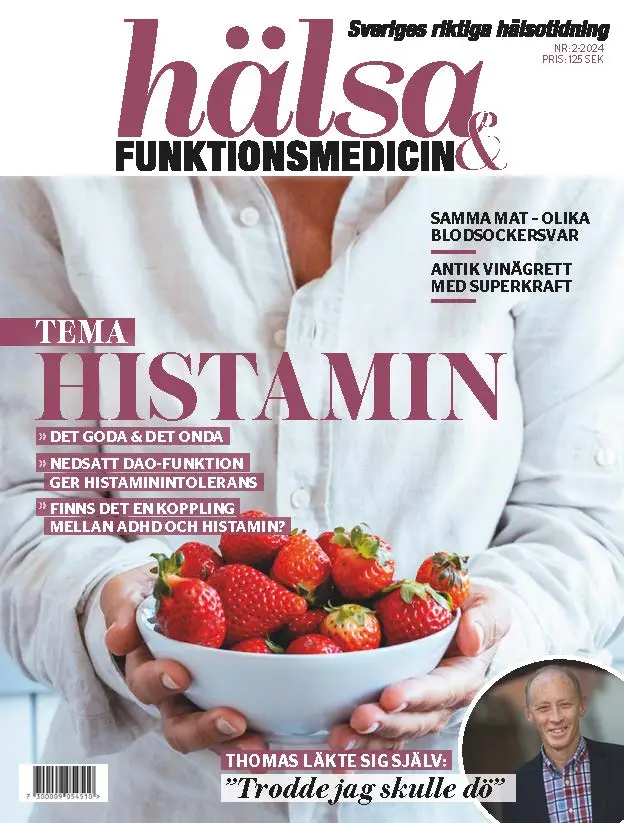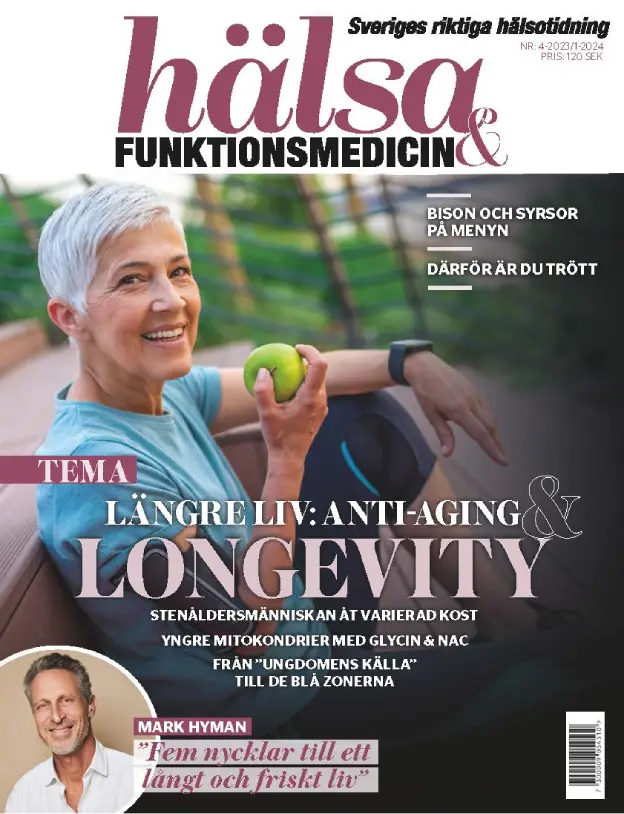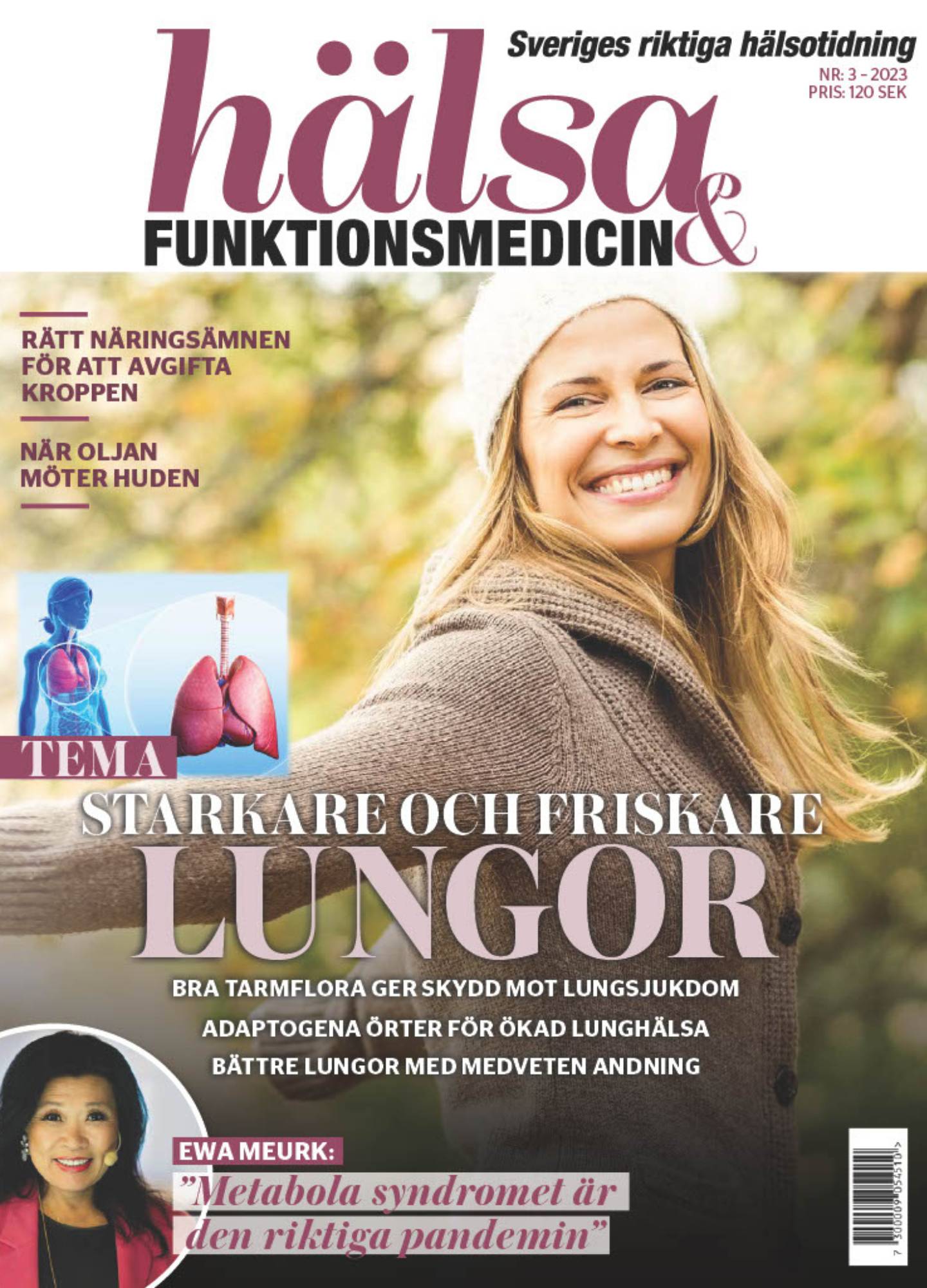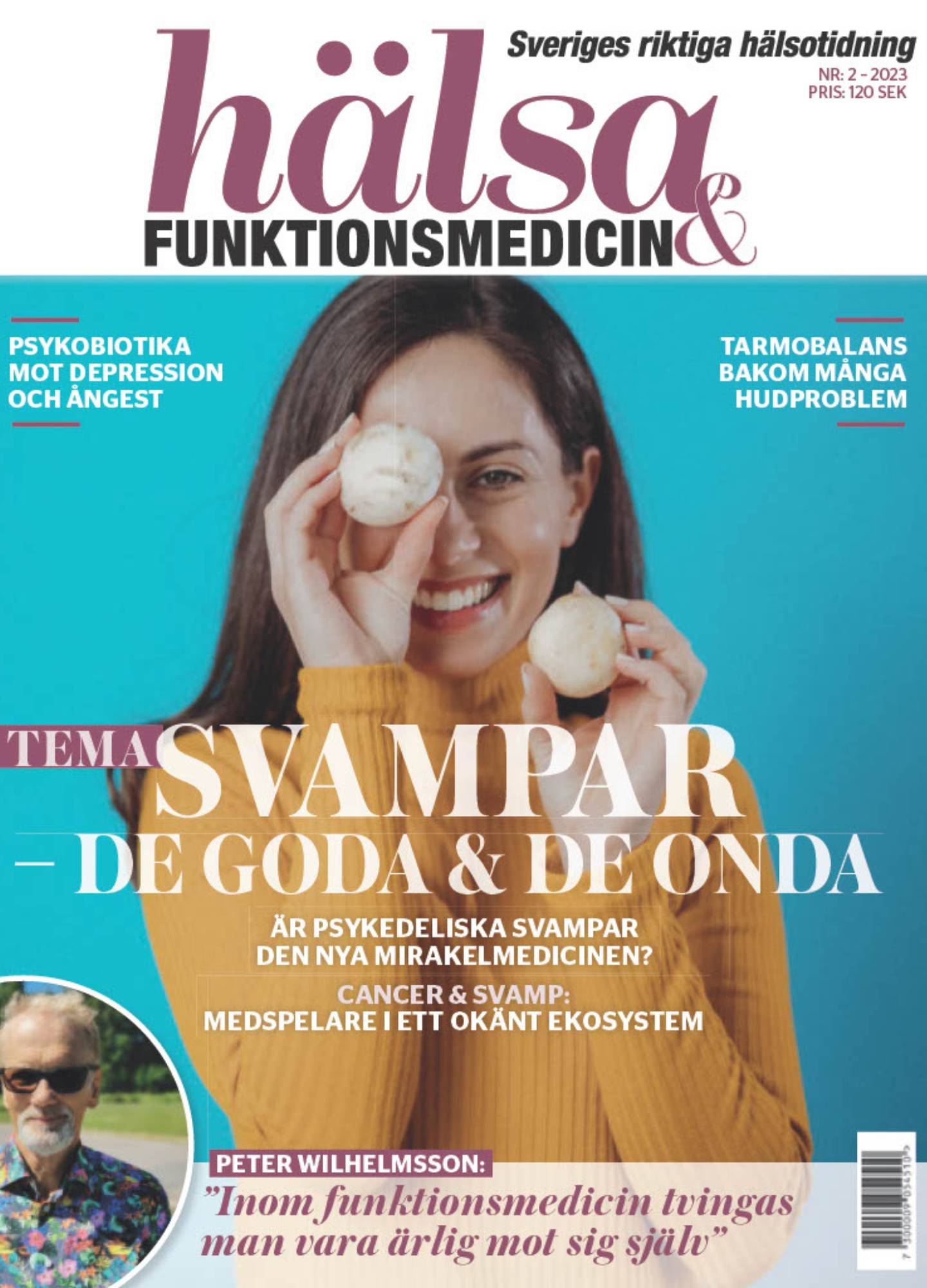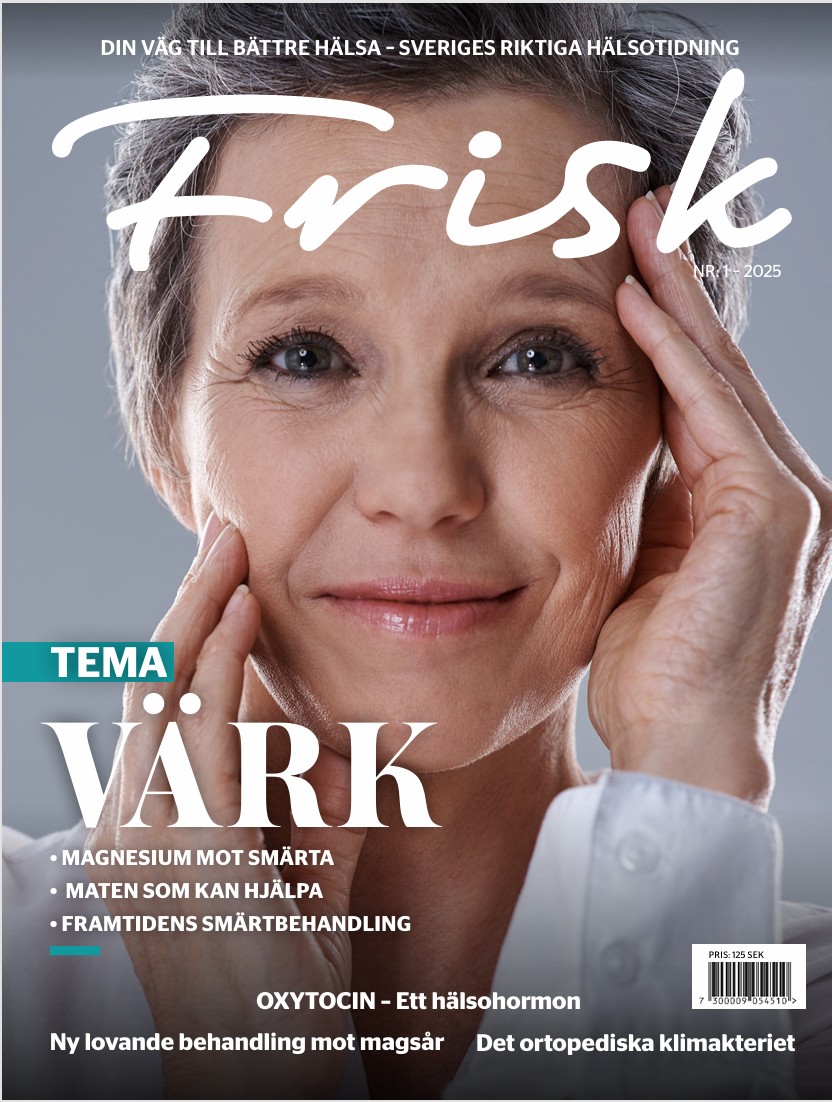
Nr 1 2025 — Värk
Magnesium kan vara effektivt vid smärta
1.Morel V., Pickering M-E., Goubayon J. et.al. Magnesium for Pain Treatment in 2021? State of the Art. Nutritents. 2021:13;5 Magnesium for Pain Treatment in 2021? State of the Art
2.Dolati S., Rikhtegar R., Mehdizadeh A., Yousefi M. The Role of Magnesium in Pathophysiology and Migraine Treatment. Biological Trace Element Research. 2020:196 DOI: 10.1007/s12011-019-01931-z
3.Alshammari E. Magnesium supplementation for premenstrual syndrome and premenstrual dysphoric disorder. International Journal of Pharmaceutical Research. 2021:13;1 DOI:10.31838/ijpr/2021.13.01.095
4.Yaralizadeh M., Nezamivand-Chegini S., Najar S., et.al. Effectiveness of Magnesium on Menstrual Symptoms Among Dysmenorrheal College Students: A Randomized Controlled Trial. 2024:12;2 pdf_IJWHR_624.pdf
5.Boulis M., Boulis M., Clauw D. Magnesium and Fibromyalgia: A Literature Review. Journal of Primary Care & Community Health. 2021. https://doi.org/10.1177/21501327211038433
6.El Sayed Z.M., Abouzeid, A.E.,El Sood A.I.A. Evaluating Effectiveness of Intravenous Magnesium Sulfate as a Treatment in Acute Renal Colic Patients Attending Suez Canal University Hospital Emergency Department. Medical Journal of Cairo University. 2019:87. DOI: 10.21608/mjcu.2019.70360
7.Jokar, A., Cyrus, A.,Babaei, M., et.al. The Effect of Magnesium Sulfate on Renal Colic Pain Relief; a Randomized Clinical Trial. Emergency. Tehran. 2017:5. The Effect of Magnesium Sulfate on Renal Colic Pain Relief; a Randomized Clinical Trial – PMC
8.Zolfaghari Sadrabad A., Azimi Abarghouei S., Farahmand Rad R. Intravenous magnesium sulfate vs. morphine sulfate in relieving renal colic: A randomized clinical trial. The American Journal of Emergency Medicine. 2021:46. DOI: https://doi.org/10.1016/j.ajem.2020.07.035
Lipödem – en missförstådd smärtsjukdom
1.Falck J, Rolander B, Nygårdh A, Jonasson LL, Mårtensson J. Women with lipoedema: a national survey on their health, health-related quality of life, and sense of coherence. BMC Womens Health. 2022 Nov 18;22(1):457.
2.Poojari A, Dev K, Rabiee A. Lipedema: Insights into Morphology, Pathophysiology, and Challenges. Biomedicines. 2022 Nov 30;10(12):3081.
3.Aksoy H, Karadag AS, Wollina U. Cause and management of lipedema-associated pain. Dermatol Ther. 2021 Jan;34(1):e14364.
4.SVT. https://www.svt.se/nyheter/inrikes/hard-kritik-mot-lipodem-varden-ett-brott-mot-halso-och-sjukvardslagen
5.Cannataro R, Michelini S, Ricolfi L, Caroleo MC, Gallelli L, De Sarro G, Onorato A, Cione E. Management of Lipedema with Ketogenic Diet: 22-Month Follow-Up. Life (Basel). 2021 Dec 15;11(12):1402.
6.Katzer K, Hill JL, McIver KB, Foster MT. Lipedema and the Potential Role of Estrogen in Excessive Adipose Tissue Accumulation. Int J Mol Sci. 2021 Oct 29;22(21):11720.
7.Herbst KL, Kahn LA, Iker E, et al. Standard of care for lipedema in the United States. Phlebology. 2021 Dec;36(10):779-796.
8.Hsiao, H., Liu, J., Pappalardo, M., & Cheng, M. The Impacts of Lymph on the Adipogenesis of Adipose-Derived Stem Cells. Plastic and Reconstructive Surgery. 2022;151:1005-1015.
9.Pfister C, Dawczynski H, Schingale FJ. Selenium Deficiency in Lymphedema and Lipedema-A Retrospective Cross-Sectional Study from a Specialized Clinic. Nutrients. 2020 Apr 25;12(5):1211.
10.Campos, C. Chronic Hyperglycemia and Glucose Toxicity: Pathology and Clinical Sequelae. Postgraduate Medicine. 2012;124:90-97.
11.Kolb H, Stumvoll M, Kramer W, Kempf K, Martin S. Insulin translates unfavourable lifestyle into obesity. BMC Med. 2018 Dec 13;16(1):232.
12.Templeman, N.M., Skovsø, S., Page, M.M., Lim, G.E., & Johnson, J.D. A causal role for hyperinsulinemia in obesity. The Journal of endocrinology. 2017;232(3):R173-R183.
13.Herrera, M., Molina, P., & Souza-Smith, F.M. Ethanol-induced lymphatic endothelial cell permeability via MAP-kinase regulation. American Journal of Physiology – Cell Physiology. 2021;321:C104-C116.
14.Doggett TM, Breslin JW. Acute alcohol intoxication-induced microvascular leakage. Alcohol Clin Exp Res. 2014 Sep;38(9):2414-26.
15. Hirose, A., Okada, Y., Morita, E., & Tanaka, Y. Benign symmetric lipomatosis associated with alcoholism. Internal medicine. 2006;45(17):1001-5.
16.Di Renzo L, Gualtieri P, Zomparelli S, et al. Modified Mediterranean-Ketogenic Diet and Carboxytherapy as Personalized Therapeutic Strategies in Lipedema: A Pilot Study. Nutrients. 2023 Aug 20;15(16):3654.
17.Lundanes J, Gårseth M, Taylor S, Crescenzi R, Pridmore M, Wagnild R, Hyldmo ÅA, Martins C, Nymo S. The effect of a low-carbohydrate diet on subcutaneous adipose tissue in females with lipedema. Front Nutr. 2024 Nov 7;11:1484612
18.Amato ACM, Benitti DA. Lipedema Can Be Treated Non-Surgically: A Report of 5 Cases. Am J Case Rep. 2021 Dec 6;22:e934406.
19.Sørlie V, De Soysa AK, Hyldmo ÅA, Retterstøl K, Martins C, Nymo S. Effect of a ketogenic diet on pain and quality of life in patients with lipedema: The LIPODIET pilot study. Obes Sci Pract. 2022 Apr 21;8(4):483-493. doi: 10.1002/osp4.580. PMID: 35949278; PMCID: PMC9358738.
20.Keith L, Seo CA, Rowsemitt C, Pfeffer M, Wahi M, Staggs M, Dudek J, Gower B, Carmody M. Ketogenic diet as a potential intervention for lipedema. Med Hypotheses. 2021 Jan;146:110435. doi: 10.1016/j.mehy.2020.110435. Epub 2020 Nov 27. PMID: 33303304.
21.Verde L, Camajani E, Annunziata G, Sojat A, Marina LV, Colao A, Caprio M, Muscogiuri G, Barrea L. Ketogenic Diet: A Nutritional Therapeutic Tool for Lipedema? Curr Obes Rep. 2023 Dec;12(4):529-543. doi: 10.1007/s13679-023-00536-x. Epub 2023 Nov 4. PMID: 37924422; PMCID: PMC10748777.
22.Jeziorek M, Chachaj A, Sowicz M, Adaszyńska A, Truszyński A, Putek J, Kujawa K, Szuba A. The Benefits of Low-Carbohydrate, High-Fat (LCHF) Diet on Body Composition, Leg Volume, and Pain in Women with Lipedema. J Obes. 2023 Nov 18;2023:5826630. doi: 10.1155/2023/5826630. PMID: 38026822; PMCID: PMC10676278.
23.Donahue PMC, Crescenzi R, Petersen KJ, Garza M, Patel N, Lee C, Chen SC, Donahue MJ. Physical Therapy in Women with Early Stage Lipedema: Potential Impact of Multimodal Manual Therapy, Compression, Exercise, and Education Interventions. Lymphat Res Biol. 2022 Aug;20(4):382-390. doi: 10.1089/lrb.2021.0039. Epub 2021 Nov 8. PMID: 34748408; PMCID: PMC9422785.
24.SGU https://www.sgu.se/anvandarstod-for-geologiska-fragor/bedomningsgrunder-for-grundvatten/grundvattnets-kvalitet–oorganiska-amnen/selen/
Hur stress och trauma påverkar kronisk värk
1.Gerdle, B., & Stålnacke, B-M. (2023). Långvarig smärta – relationen till ångest och depression är komplex. Läkartidningen https://lakartidningen.se/klinik-och-vetenskap-1/artiklar-1/klinisk-oversikt/2023/06/langvarig-smarta-relationen-till-angest-och-depression-ar-komplex/
2.Breivik, H. (2006). Survey of chronic pain in Europe: Prevalence, impact on daily life, and treatment. European Journal of Pain, 10, 287-333.
3.George, J. Chronic pain is rising, and it’s not clear why. MedPage Today https://www.medpagetoday.com/neurology/painmanagement/113149
4. Region Stockholm. (2023). Smärta. Folkhälsorapport Stockholm. https://www.folkhalsorapportstockholm.se/rapporten2/sjukdomar-och-skador/smarta
5.The Guardian. Number of people with chronic pain in England to rise by 1.9 m by 2040. https://www.theguardian.com/society/2024/oct/21/number-of-people-with-chronic-pain-in-england-to-rise-by-19m-by-2040
6.Macchia, L., & Oswald, A. J. (2021). Physical pain, gender, and the state of the economy in 146 nations. Social Science & Medicine, 287, 114332.
7.Försäkringskassan. Rekordmånga sjukskrivs för stress. https://www.forsakringskassan.se/nyhetsarkiv/nyheter-press/2024-11-18-rekordmanga-sjukskrivs-for-stress
8.FN, https://www.iwsthlm.se/wp-content/uploads/2016/02/BVB_2016-UNDP.pdf.
9.Kascakova, N., Furstova, J., Hasto, J., Madarasova Geckova, A., & Tavel, P. (2020). The Unholy Trinity: Childhood Trauma, Adulthood Anxiety, and Long-Term Pain. International Journal of Environmental Research and Public Health, 17(2), 414.
10.Lumley MA, Cohen JL, Borszcz GS, Cano A, Radcliffe AM, Porter LS, Schubiner H, Keefe FJ. Pain and emotion: a biopsychosocial review of recent research. J Clin Psychol. 2011 Sep;67(9):942-68. doi: 10.1002/jclp.20816. Epub 2011 Jun 6. PMID: 21647882; PMCID: PMC3152687.
11.https://www.forskning.se/2025/02/04/endometrios-smarta-forskning/
12.Rivi, V., Rigillo, G., Toscano, Y., Benatti, C., & Blom, J. M. C. (2023). Narrative Review of the Complex Interaction between Pain and Trauma in Children: A Focus on Biological Memory, Preclinical Data, and Epigenetic Processes. Children, 10(7), 1217.
13.Stumbo, S. P., Yarborough, B. J., McCarty, D., Weisner, C., & Green, C. A. (2017). Patient-reported pathways to opioid use disorders and pain-related barriers to treatment engagement. Journal of Substance Abuse Treatment, 73, 47-54.
14.Mischkowski, D., Crocker, J., & Way, B. M. (2019). A Social Analgesic? Acetaminophen (Paracetamol) Reduces Positive Empathy. Frontiers in Psychology, 10, 538.
15.DeWall C. N., MacDonald G., Webster G. D., Masten C. L., Baumeister R. F., Powell C., et al. (2010). Acetaminophen reduces social pain: behavioral and neural evidence. Psychol. Sci. 21, 931-937.
16.Randles D, Heine SJ, Santos N. The common pain of surrealism and death: acetaminophen reduces compensatory affirmation following meaning threats. Psychol Sci. 2013 Jun;24(6):966-73.
17.Cosgrove, K. T., Kuplicki, R., Savitz, J., Burrows, K., Simmons, W. K., Khalsa, S. S., Teague, T. K., Aupperle, R. L., & Paulus, M. P. (2021). Impact of ibuprofen and peroxisome proliferator-activated receptor gamma on emotion-related neural activation: A randomized, placebo-controlled trial. Brain, Behavior, and Immunity, 96, 135-142.
18.Vetenskap och hälsa. (n.d.). När stressen sätter sig i käkarna.
19.Dutra Dias, H., Botelho, A.L., Bortoloti, R., & dos Reis, A.C. (2021). Neuroscience contributes to the understanding of the neurobiology of temporomandibular disorders associated with stress and anxiety. CRANIO®, 42, 439-444.
20.Vinstrup, J., Jakobsen, M. D., & Andersen, L. L. (2020). Perceived Stress and Low-Back Pain Among Healthcare Workers: A Multi-Center Prospective Cohort Study. Frontiers in Public Health, 8, 297.
21.Yip, Y. B., Ho, S. C., & Chan, S. G. (2001). Socio-psychological stressors as risk factors for low back pain in Chinese middle-aged women. Journal of Advanced Nursing, 36(3), 409-416.
22.Kennedy, C., Kassab, O., Gilkey, D., Linnel, S., & Morris, D. (2008). Psychosocial factors and low back pain among college students. Journal of American College Health, 57(2), 191-195.
23.Takegami, N., Akeda, K., Yamada, J., Nishimura, A., & Sudo, A. (2024). Association between low back pain and psychological stress response in a Japanese population-based study. Journal of Orthopaedic Science, 29(3), 749-754.
24.Power, C., Frank, J., Hertzman, C., Schierhout, G., & Li, L. (2001). Predictors of low back pain onset in a prospective British study. American Journal of Public Health, 91, 1671-8.
25.Reigo, T., Tropp, H., & Timpka, T. (2001). Absence of back disorders in adults with work-related predictive factors in a 5-year perspective. European Spine Journal, 10, 215-220.
26.Linton, S. J. (2001). Occupational psychological factors increase the risk for back pain: a systematic review. Journal of Occupational Rehabilitation, 11, 53-66.
27.Hallberg, H., Maroti, D., Lumley, M. A., & Johansson, R. (2025). Internet-delivered emotional awareness and expression therapy for somatic symptom disorder: one year follow-up. Frontiers in Psychiatry, 15, 1505318.
28.Maroti, D., Ljótsson, B., Lumley, M. A., Schubiner, H., Hallberg, H., Olsson, PÅ, & Johansson, R. (2021). Emotional Processing and Its Association to Somatic Symptom Change in Emotional Awareness and Expression Therapy for Somatic Symptom Disorder: A Preliminary Mediation Investigation. Frontiers in Psychology, 12, 712518.
29.Samulowitz, A., Gremyr, I., Eriksson, E., & Hensing, G. (2018). ”Brave Men” and ”Emotional Women”: A Theory-Guided Literature Review on Gender Bias in Health Care and Gendered Norms towards Patients with Chronic Pain. Pain Research and Management, 2018, 6358624.
30.Goebel, A., Krock, E., Gentry, C., Israel, M. R., Jurczak, A., Urbina, C. M., Sandor, K., Vastani, N., Maurer, M., Cuhadar, U., Sensi, S., Nomura, Y., Menezes, J., Baharpoor, A., Brieskorn, L., Sandström, A., Tour, J., Kadetoff, D., Haglund, L., Kosek, E., Bevan, S., Svensson, C. I., & Andersson, D. A. (2021). Passive transfer of fibromyalgia symptoms from patients to mice. Journal of Clinical Investigation, 131(13), e144201.
31.Poojari, A., Dev, K., & Rabiee, A. (2022). Lipedema: Insights into Morphology, Pathophysiology, and Challenges. Biomedicines, 10(12), 3081.
32.Maddern, J., Grundy, L., Castro, J., & Brierley, S. M. (2020). Pain in Endometriosis. Frontiers in Cellular Neuroscience, 14, 590823.
Matpyramid mot kronisk smärta
1.Rondanelli M, Faliva MA, Miccono A, Naso M, Nichetti M, Riva A, Guerriero F, De Gregori M, Peroni G, Perna S. Food pyramid for subjects with chronic pain: foods and dietary constituents as anti-inflammatory and antioxidant agents. Nutr Res Rev. 2018 Jun;31(1):131-151.
2.Schols, J.M.G.A., De Groot, C.P.G.M., Van der Cammen, T.J.M. and Olde Rikkert, M.G.M. (2008) Preventing and treating dehydration in the elderly during periods of illness and warm weather. The Journal of Nutrition Health and Aging. 13 (2), 150–57.
3.Eurostat. How much fruit and vegetables do you eat daily? 4 Jan 2022. (Hämtad 2025-01-07) How much fruit and vegetables do you eat daily? – Products Eurostat News – Eurostat
4.Albin Lindström, Socialstyrelsen skärper alkoholråd – fyra öl vid ett tillfälle är riskbruk. Läkartidningen 2023-09-12. (Hämtad 2025-01-07) Socialstyrelsen skärper alkoholråd – fyra öl vid ett tillfälle är riskbruk
5.Guagnano MT, D’Angelo C, Caniglia D, Di Giovanni P, Celletti E, Sabatini E, Speranza L, Bucci M, Cipollone F, Paganelli R. Improvement of Inflammation and Pain after Three Months’ Exclusion Diet in Rheumatoid Arthritis Patients. Nutrients. 2021 Oct 9;13(10):3535.
Mindre kolhydrater, mindre smärta
1.Real Life Medicine. Can Diet Help with Chronic Pain? Poddavsnitt 101. https://www.rlmedicine.com/
2.Field R, Pourkazemi F, Turton J, Rooney K. Dietary Interventions Are Beneficial for Patients with Chronic Pain: A Systematic Review with Meta-Analysis. Pain Med. 2021 Mar 18;22(3):694-714.
3.Field R, Field T, Pourkazemi F, Rooney K. Ketogenic diets and the nervous system: a scoping review of neurological outcomes from nutritional ketosis in animal studies. Nutr Res Rev. 2022 Dec;35(2):268-281.
Framtidens smärtbehandling
1.Deer TR, Grider JS, Lamer TJ, Pope JE, Falowski S, Hunter CW, Provenzano DA, Slavin KV, Russo M, Carayannopoulos A, Shah JM, Harned ME, Hagedorn JM, Bolash RB, Arle JE, Kapural L, Amirdelfan K, Jain S, Liem L, Carlson JD, Malinowski MN, Bendel M, Yang A, Aiyer R, Valimahomed A, Antony A, Craig J, Fishman MA, Al-Kaisy AA, Christelis N, Rosenquist RW, Levy RM, Mekhail N. A Systematic Literature Review of Spine Neurostimulation Therapies for the Treatment of Pain. Pain Med. 2020 Nov 7;21(7):1421-1432. doi: 10.1093/pm/pnz353. Erratum in: Pain Med. 2021 Feb 4;22(1):236. doi: 10.1093/pm/pnaa209. PMID: 32034422.
2.Strand N, J M, Tieppo Francio V, M M, Turkiewicz M, El Helou A, M M, S C, N S, J P, C W. Advances in Pain Medicine: a Review of New Technologies. Curr Pain Headache Rep. 2022 Aug;26(8):605-616. doi: 10.1007/s11916-022-01062-6. Epub 2022 Jul 29. PMID: 35904729; PMCID: PMC9334973.
3. https://www.akademiska.se/for-vardgivare/sektioner/smartcentrum/ryggmargsstimulering/
4. https://www.lu.se/artikel/smartlindring-utan-biverkningar-med-sjograsmjuk-teknik
5.Forni M, Thorbergsson PT, Thelin J, Schouenborg J. 3D microelectrode cluster and stimulation paradigm yield powerful analgesia without noticeable adverse effects. Sci Adv. 2021 Oct 8;7(41):eabj2847. doi: 10.1126/sciadv.abj2847. Epub 2021 Oct 8. PMID: 34623922; PMCID: PMC8500508.
6.Holmkvist, A.D., Agorelius, J., Forni, M. et al. Local delivery of minocycline-loaded PLGA nanoparticles from gelatin-coated neural implants attenuates acute brain tissue responses in mice. J Nanobiotechnol 18, 27 (2020). https://doi.org/10.1186/s12951-020-0585-9
7. https://www.lu.se/artikel/nanopartiklar-kommer-lastade-med-lakemedel-till-hjarnan
8. Slitzky M, Yong RJ, Lo Bianco G, Emerick T, Schatman ME, Robinson CL. The Future of Pain Medicine: Emerging Technologies, Treatments, and Education. J Pain Res. 2024 Aug 30;17:2833-2836. doi: 10.2147/JPR.S490581. PMID: 39228514; PMCID: PMC11370752.
9. Logan DE, Simons LE, Caruso TJ, Gold JI, Greenleaf W, Griffin A, King CD, Menendez M, Olbrecht VA, Rodriguez S, Silvia M, Stinson JN, Wang E, Williams SE, Wilson L. Leveraging Virtual Reality and Augmented Reality to Combat Chronic Pain in Youth: Position Paper From the Interdisciplinary Network on Virtual and Augmented Technologies for Pain Management. J Med Internet Res. 2021 Apr 26;23(4):e25916. doi: 10.2196/25916. PMID: 33667177; PMCID: PMC8111507.
10. Li A, Montaño Z, Chen VJ, Gold JI. Virtual reality and pain management: current trends and future directions. Pain Manag. 2011 Mar;1(2):147-157. doi: 10.2217/pmt.10.15. PMID: 21779307; PMCID: PMC3138477.
12. Henderson I, Elsaadany R, Chan G, Bajaj V, Duarte D, Goodman S, Grunstein M, Vadhan NP, Duarte RA. Exploring the Potential of Psychedelics in the Treatment of Headache Disorders: Clinical Considerations and Exploratory Insights. Curr Pain Headache Rep. 2025 Jan 16;29(1):28. doi: 10.1007/s11916-024-01321-8. PMID: 39820774
13. Lin C, Wang X, Wang X. Exploring the Therapeutic Potential of Psychedelics in Chronic Pain Management: A New Frontier in Medicine. Neurosci Bull. 2025 Jan 20. doi: 10.1007/s12264-025-01351-1. Epub ahead of print. PMID: 39832122.
14. Barber G, Nemeroff CB, Siegel S. A Case of Prolonged Mania, Psychosis, and Severe Depression After Psilocybin Use: Implications of Increased Psychedelic Drug Availability. The American Journal of Psychiatry. 2022 Dec;179(12):892-896. DOI: 10.1176/appi.ajp.22010073. PMID: 36453037.
15. Bremler, R., Katati, N., Shergill, P. et al. Case analysis of long-term negative psychological responses to psychedelics. Sci Rep 13, 15998 (2023). https://doi.org/10.1038/s41598-023-41145-x
16. Bonnelle V, Smith WJ, Mason NL, Cavarra M, Kryskow P, Kuypers KP, Ramaekers JG, Feilding A. Analgesic potential of macrodoses and microdoses of classical psychedelics in chronic pain sufferers: a population survey. Br J Pain. 2022 Dec;16(6):619-631. doi: 10.1177/20494637221114962. Epub 2022 Jul 14. PMID: 36452124; PMCID: PMC9703241.
En ny behandling av magsårsbakterien
1.Hooi JKY, Lai WY, Ng WK, Suen MMY, Underwood FE, Tanyingoh D m.fl. Global Prevalence of Helicobacter pylori Infection: Systematic Review and Meta-Analysis. Gastroenterology. 2017;153(2):420-9.
2.Tacconelli E, Carrara E, Savoldi A, Harbarth S, Mendelson M, Monnet DL, et al. Discovery, research, and development of new antibiotics: the WHO priority list of antibiotic-resistant bacteria and tuberculosis. Lancet Infectious Diseases. 2018;18(3):318-27.
3.Holz C, Busjahn A, Mehling H, Arya S, Boettner M, Habibi H, et al. Significant Reduction in Helicobacter pylori Load in Humans with Non-viable Lactobacillus reuteri DSM17648: A Pilot Study. Probiotics and Antimicrobial Proteins. 2015;7(2):91-100.
4.Mehling H, Busjahn A. Non-Viable Lactobacillus reuteri DSMZ 17648 (Pylopass (TM)) as a New Approach to Helicobacter pylori Control in Humans. Nutrients. 2013;5(8):3062-73
5.Buckley M, Lacey S, Doolan A, Goodbody E, Seamans K. The effect of Lactobacillus reuteri supplementation in Helicobacter pylori infection: a placebo-controlled, single-blind study. Bmc
6.2018;4(1):1-8.
7.Muresan IAP, Pop LL, Dumitrascu DL. Lactobacillus reuteri versus triple therapy for the eradication of Helicobacter pylori in functional dyspepsia. Med Pharm Rep. 2019;92(4):352-5.
8.Parolova NI, Kornienko EA, Antonov PV, Egorova MB, Gorbunov EF, Dmitrienko MA. An innovative approach in the treatment of H. pylori infection in children. Russian Medical Journal2015.
9.Kornienko EA, Parolova NI, Ivanov SV, Polev DS, Zykin PA, Kondratenko YD, et al. Gastric microbiota and probiotics opportunities in helicobacter pylori eradication in children. Gastroenterology & Hepatology: Open Access. 2020;11(1):13-23.
A-vitamin och betakaroten för hudens hälsa
1.Offord E.A, Gautier J.C., Avanti O., et al. Photoprotective potential of lycopene, beta-carotene, E-vitamin, C- and A-vitamin and carnosic acid in UVA-irradiated human skin fibroblasts. Free radical biology and medicine. 2002:32;12 DOI: https://doi.org/10.1016/S0891-5849(02)00831-6
2.Kurokawa I et.al. New developments in our understanding of acne pathogenesis and treatment. Experimental Dermatology. 2009;18 DOI: 10.1111/j.1600-0625.2009.00890.x
3.Nagata C, Nakamura K, Wada K et.al. Association of dietary fat, vegetables and antioxidant micronutrients with skin ageing in Japanese women. British Medical Journal. 2010;103 DOI:10.1017/S0007114509993461
4.Leung W.C., Hessel S, Méplan C., et.al. Two common single nucleotide polymorphisms in the gene encoding β-carotene 15,15′-monoxygenase alter β-carotene metabolism in female volunteers. FASEB Journal. 2008:23;4 DOI: https://doi.org/10.1096/fj.08-121962
Fosfolipider: Cellmembranens livsviktiga byggstenar
1.Nylander M (1994) Antioxidanter – Skyddet mot fria radikaler. Faktaskrift som utgivits av Hälsokostrådet. Förlag: Hälsokostrådets Förlag. Tryckeri: TryckeriEtt 1993. ISBN: 91 86170 57-0
2.Nylander M (1994) FREE RADICALS – ANTIOXIDANTS. In: Heavy Metal Bulletin, Volyme 1 -Issue 2, October 1994 (bil.VI:4D).Tysk version: Freie Radikale – antioxidanten. Schwermetall Bulletin.
3.Nylander M & Carlmark B (2009) Vad är oxidativ stress. Näringsmedicinsk tidskrift 3:9-10, 21-22.
4.Nylander M (2011) Oxidativ stress. STARK 3:35-38.
5.Nylander M (2014) Oxidativ stress är vanligast bland medelålders kvinnor. Medicinsk Access 3:6-11.
6.Nicolson G L et al (2024) Membrane Lipid Replacement and its Role in Restoring Mitochondrial Membrane Function and Reducing Symptoms in Aging and Age-related Clinical Conditions. Nature Cell and Science 2(4):238-256.
7.Singer SJ & Nicolson GL (1972) The fluid mosaic model of the structure of cell membranes. Science; 175 (4023):720-31.
8.Agadjanyan M et al (2003) Nutrtional supplement (NTFactor®) restores mitochondrial function and reduce moderately severe fatigue in aged subjects. J. Chronic. Fatigue Syndr; 11(3):23-36.
9.Nicolson GL et al (2017) Membrane Lipid Replacement for chronic illnesses, aging and cancer using oral glycerolphospholipid formulations with fructooligosaccharides to restore phodpholipid function in cellular membranes, organelles, cells and tissues. Biochim. Biophys. Acta Biomembr; 1859(9):1704-1724.
10.Ellithorpe RA et al (2015) Blood homocysteine and fasting insulin levels are reduced and erythrocyte sedimentation rates are increased with a glycophospholipid vitamin formulation: a retrospective study in older subjects. Funct. Foods Health Dis; 5(4):126-135.



